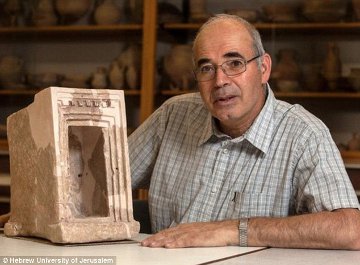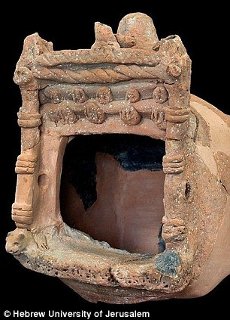Jewish Shrines for David
The excavations at Khiret Quiyafa have been widely hailed as providing positive evidence against Israel Finkelstein and his "minimalist" school which denies the David or Solomon existed - or if they did, they were little more than petty chieftans of an insignificant tribe.
The first excavations on the site uncovered an impressive fortress in a strategically important site for anyone wanting to confront the Philistine threat. In fact, Khirbet Qeiyafa overlooks the Valley of Elah, the site of David's famous confrontation with Goliath of Gath! It is even possible that the Philistines were attacking Israel on this occasion precisely because Saul and his men were building this fortress and thereby challenging Philistine domination! The fortress was large enough to be beyond the capabilities of a mere "petty chieftan".
Even more significantly, the excavators discovered a number of ostraca which were written on in ancient Hebrew - not Philistine or Canaanite, but Hebrew. The ostraca hinted at the levying of taxes and a centralised administration that covered a large area - both of which would, presumably, be beyond the powers of a "petty chieftan".
The latest discoveries confirm the identification of Khirbet Qeiyafa as an Israelite fortress and at the same time pose a challenge to an overly simplistic reading of the Biblical story.
The confirmation comes from a report by Yosef Garfinkel, archaeologist at the Hebrew University of Jerusalem, in which he states that although numerous bones and other food remains have been uncovered in the rubbish heaps of the fortress, there is not a single pig bone among them. Pigs were popular food animals among other populations in Palestine, so the fact that they are absent from Khirbet Qeiyafa is evidence that the people there were Jews and that they were keeping the Biblical prohibition on the eating of unclean meats.

| |
| Dr Yosef Garfinkel with a stone shrine uncovered in the ruins of Khirbet Qeiyafa |
The challenge comes from other discoveries in the ruins: three large rooms that contained what can only be described as "ritual objects" and which, presumably, functioned as shrines. Scattered between the three rooms the archaeologists found five standing stones, two altars made of basalt - indicating that they had been brought to the area from some distance away, two libation vessels made of pottery and, most interesting of all, two boxes shaped like temples.
It is these boxes, often called "portable shrines", that are arousing the most interest. One is made of pottery and one of stone and such shrines frequently have an image of some sort carved into them, presumably representing the god who was worshipped. Both the Khirbet Qeiyafa shrines are empty boxes.
We know that the makers were not opposed to representational art, because the clay shrine is decorated with an elaborate facade of pillars and stylised curtains and in addition has two lions out the front and three birds perched on the roof! There is, however, no sign of any creature or being inside the shrine, which is where an image of the god would be placed.

| |
| The pottery shrine with pillars either side and stylised drapery above the entrance. Three crude birds perch on the roof and a lion's head can be discerned on the bottom left. |
Yosef Garfinkel claims this is further evidence that the people of Khirbet Qeiyafa were Jews, obedient to the second commandment which forbids the making of images for worship.
I am inclined to agree with him - the two findings, taken together, do indeed point to a Jewish population observing the twin prohibitions of the Mosaic law against pork and against representations of the deity. The problem is those standing stones!
The prophets of the Old Testament frequently inveighed against "the groves" or "the Asherah", in which upright objects such as trees, posts, or standing stones were used as representations of God. The famous Obelisk Temple at Byblos has a whole courtyard filled with these standing stones. It might be thought that a monotheistic religion opposed to idols would avoid such symbols.
There is, however, another possible explanation: when we take our tour groups to Petra they are intrigued by the many "god boxes" to be seen in the Siq and elsewhere. It seems that the Nabateans had a similar prohibition on the representation of "anything in heaven or on earth or under the earth", but feeling that they needed a focus for their devotions, they made do with simple, unadorned, rectangular blocks of stone.
The curious thing is that the Nabateans were an Arab tribe, and this practice of venerating blocks of stone as gods was practised by other Arab tribes, including the inhabitants of Mecca. When Mohammed took over Mecca and imposed Islam as the only acceptable religion, he nonetheless preserved the most sacred of these blocks of stone which, as the Ka'aba is still a focus of Muslim devotion!
The trouble with such compromises is that they are so liable to misunderstanding and perversion. Representations of saints in Roman Catholic churches, which everyone in the West clearly understands are mere likenesses and not objects of worship, are worshipped with great devoutness in less sophisticated and educated parts of the world such as South America. In the same way, a standing stone intended to be a mere "god block" could be easily misinterpreted by later generations as representing the same as the obelisks worshipped by their Canaanite neighbours.
Still, it may be a shock to some to discover that Israelites in the time of Samuel worshipped in this way. It is easy for us to think of the Jews holding some sort of semi-Protestant worship service, forgetting that with animal sacrifices common, the religion back then would probably have been pretty alien to most Christians. Drink offerings - libations - and incense, standing stones at the back of the worship room, an empty shrine as the focus of attention. It was definitely not Church of England!
representations of God There is some uncertainty about what these groves represent. Everyone agrees that they served a fertility cult, but whether their upright nature indicated the male principle, or the fact that they surrounded a male god indicated the female principle, is unclear. If it seems odd that people should worship a phallus, you have only to look at Hinduism, where the sacred lingam, a stylised representation of a phallus, is not only a popular object of worship, but is frequently surrounded by a sort of collar which is intended to represent female genitalia being penetrated. Return
unadorned That these blocks of stone were intended as objects of worship is shown by the single exception to this rule of "unadorned". Half-way down the Siq, on the left, there is an elaborate shrine in which is carved one of these blocks, but this one has rectangles carved onto it in relief as stylised eyes and a nose! Return
<© Kendall K. Down 2012





